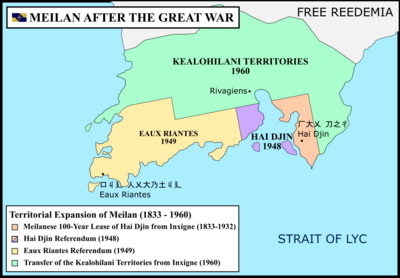Meilan

|
Assembly of Nations Mandate for Meilan Mandat tigrisien de Meilan (Valonian) Population: 1,077,085 (2020)
|
Loading map... |
Meilan (Ingerish: may-LAHN; Valonian: Meilan "mɛlɑ̃", officially the Assembly of Nations Mandate for Meilan or Mandatory Meilan, is an Assembly of Nations mandate territory on the Budrian Peninsula in the Rivages of Tarephia. Meilan is bordered on the north by Freedemia. Across the Strait of Lyc to the south is Geare. The administrative center and largest city of Meilan is Eaux Riantes. By Assembly of Nations resolution, Tigeria has administered the territory's defense since the Great War.
Due to its location on the Strait of Lyc, Meilan plays a strategic role in the policies of the Lycene region, Tarephia, and worldwide. Meilan is a member of the Tarephia Cooperation Council and the Lycene League. It is the headquarters of the Inter-Tarephian Border Guards, the Assembly of Nations University, and the Alliance des Pays Pétroliers∈⊾.
The future political status of Meilan has raised much significant debate both within and without Meilan. Meilan continues to coordinate with the Assembly of Nations, the Tarephia Cooperation Council, the Lycene League and other nations of interest as it continues to assert its right to self-determination.
Etymology
The name Meilan derives from a combination of the two regions that made up the region of legendary Meilan, Meishan (Meilanese: 冂乁山天) and Lanyun (Meilanese: 了天乂一). Prior to the formation of Mandatory Meilan, the Meilanese character lan in Lanyun was changed from 兰 (meaning orchid) to 蓝 (meaning blue) for reasons unknown. It is widely suspected that a transcription error resulted in this change, and it was gone unnoticed because the transcribed Valonian name remained the same. However, the name of the new republic retained the old character 兰, resulting in the continued use of the name Meilan (Meilanese: 美兰) to refer to the territory.
History
Indigenous Inxignese
The indigenous Inxignese established the earliest permanent settlements in the region as outposts of their trade network centered on the islands of Inxigne.
Valonian Settlements and Meilanese Contact (1200 - 1450)
As Valonian settlers arrived from the west, some settled in what is today Broceliande while others settled in Inxigne. They migrated along the Inxignese trade routes to what is now Meilan. As Meilanese started arriving from the east, they established trade relations with the Valonians.
Meilanese Settlements and Bai Contact (1450 - 1550)
In the late fifteenth century, Inxignese influence over the region waned, and Meilanese migrations into the region increased. As the region become wealthier from Meilanese trade, the Valonian and Meilanese communities established the city-states of Eaux Riantes and Hai Djin in Meilan. As these two city-states grew prosperous, the attracted mercantile traders from farther abroad, including the Bai. Word of the Meilanese trade empire spread along Bai trade routes, and the Bai Empire sought to influence trade through the Strait of Lyc.
Goxianese Thalassocracy (1450 - 1750)
The presence of Bai Empire spurred the Meilanese to call for greater unity among their city states from Linshanford in Tigeria to Hai Djin in Meilan. By skillful political maneuvering, the Meilanese solidified their power in the western Lycene region under the Goxianese house of Long Sun. The House of Long Sun ruled administered the thalassocracy from Meilinmen, Tigeria.
Pays-Rivageois and Inxigne (1750 - 1930)

The strength of the Goxianese empire drew the ire of Broceliandais merchants who had to pay increasingly hefty dues to the Goxianese for access to the sea. The elites looked for ways to make the trade situation more favorable to the Broceliandais, and as power passed to the Valonian house of Beau Soleil, it seemed that a unified Valonian kingdom was more likely. The establishments of the Tigerine republics interrupted the consolidation of Valonian power in the early seventeenth century. During this time, Meilan passed from Goxia to Valony in an administrative reformation. As the seat of administration moved from Meilinmen, Tigeria to Valoris, Broceliande, many social reforms came to Meilan in a move to introduce greater allegiance to Broceliande. The Meilanese received these social reforms with mixed reactions. Some Meilanese advocated for independence while others sought the allegiance of various powers in the Strait of Lyc. During this time, the administration of the territories passed to Inxigne, as Meilan and Inxigne remained the most distant territories of Valony. Inxigne would administer the territories from Maracaram until the Great War.
Great War Occupation and the Lycene Blockades (1930 - 1940)
Both Antarephian and Tarephian Meilan become occupied during the Great War as various parties sought to control the Strait of Lyc. Recognizing Meilan's crucial position to global maritime navigation, the occupying powers orchestrated a series of blockades to close the Strait of Lyc to maritime traffic and force ships to call at Eaux Riantes. As the region faced economic disruptions, many Meilanese migrated to Tigeria during this time to flee from political persecution or economic hardships. At the end of the war, the global community quickly realized that the dissolution of Antarephian Meilan meant that the Meilanese diaspora had no homeland except for Tarephian Meilan. The strategic location of Tarephian Meilan and the desire of the Meilanese people to have a homeland raised the question of who should have control of Tarephian Meilan and the Strait of Lyc.
Assembly of Nations Mandate (1940 - Present Day)
Due to domestic political pressure, Inxigne did not want to integrate Eaux Riantes and Hai Djin back into its territories, and the Meilanese turned to the Assembly of Nations for another solution. Consulting with Inxigne, the Assembly of Nations, under the administration of Secretary General Kai Kealohilani, decided to establish a mandate over the regions of Eaux Riantes and Hai Djin in Meilan to set aside for the Meilanese poeple. The mandate had the dual goals of establishing stability over the Strait of Lyc and preparing the Meilanese people for self-determination. After much debate over who should administer the mandate for Meilan, the general assembly of the Assembly of Nations awarded the mandate to Tigeria. The Kealohilani administration subsequently realized that the Meilanese remained vulnerable to sociopolitical forces in the Lycene region. Working in conjunction with the Tigerine and Inxignese governments, the Kealohilani administration secured additional territories and maritime waters from Inxigne. Meilan would acquire these territories for defense, economic diversification, and future population expansion. Today, these additional territories are named in Kealohilani's honor, and the borders of Meilan were established as they stand today.
Various referenda have been held on Meilan's future status as a political entity. Options offered to the Meilanese have included integration with Inxigne, integration with Tigeria, and other changes to the status quo. A majority of voters have favored a closer relationship to Tigeria. Since Inxigne has rejected integration with Meilan, and since Tigeria has not acted on the referenda, Meilan continues to remain an Assembly of Nations mandate.
Geography, Climate, and Environment
Meilan enjoys a humid tropical climate, due to its proximity to the Equator. Summer is hot and humid with occasional showers and thunderstorms, and warm air coming from the northwest. Winters are mild and sunny, with coastal temperatures moderated by their proximity to the ocean. Mountainous regions are often cooler, while the inland plains remain hot but dry.
A series of low mountains run along the peninsula. The Corelia Highlands define the center of Meilan, and divide the western Cornelia valley from the eastern Corelia valley. The Cornelia and the Corelia rivers are the two major rivers of Meilan; they rise in Freedemia and flow south to Meilan.
Demographics
Migration
Meilan is a major point of entry for undocumented migrants and refugees trying to enter Tarephia. These migrants originate from several places in Antarephia and cross the Strait of Lyc opposite Eaux Riantes. The majority of migrants use Meilan as a transit country, while their intended destinations are farther north.
Government and Politics
The Mandate of Meilan is governed by a High Commissioner which serves as the head of state and leader of the executive and legislative branches of the territory. Meilan has national assembly that meets in the Great Hall in Eaux Riantes. The executive branch consists of the High Commissioner and the advisory councils. The third branch of government, the judicial branch, is headed by a Supreme Justice of the Republic with four associate justices.
Administrative divisions
The territory of Meilan has three administrative divisions:
- Eaux Riantes
- Hai Djin
- Kealohilani Territories
Foreign Relations
Since the Great War, Tigeria has administered Meilan. On the international stage, the ambassador of Tigeria has represented the interests of Meilan.
Economy
Meilan's economy is driven by five primary industries: agriculture and fishing, oil/gas, forestry, manufacturing, banking/finance. The inland regions of the Corelia Valley and Cornelia Valley are plentiful in arable land, resulting in a burgeoning economy of coffee, cocoa, rice, and various fruits and vegetables. The discovery of oil deposits along the eastern and southern coasts has created a burgeoning oil and gas industry. Forestry is a crucial component of the economy in the Corelia Highlands, with its many forests. Manufacturing is important in many of the commercial centres of the country, with a wide variety of products and exports ranging from textile, clothing, and electronics. Eaux Riantes and Hai Djin are also important banking/finance centers, with Eaux Riantes considered one of the world's most important trade and commerce centers.
Oil and Natural Gas
Meilan has extensive oil and natural gas deposits off its eastern shore, and the territory earns revenues from the leases it offers to oil and gas companies to drill offshore. The profits from the oil and gas industries provide dividends to the Meilanese people through the Meilan Permanent Fund. Since the disastrous 1986 Tambourfleurs oil spill, Meilan has imposed a moratorium on new leases for oil and natural gas drilling within its territorial waters.
Transportation
Air
Meilan currently has the following airports:
- Kai Kealohilani International Airport
The nation's flag carrier is Air Meilan, which serves various national and international destinations.
Rail
Rail transport did not arrive in Meilan until the 1900s, which results in a relatively underdeveloped rail network that is currently undergoing rapid expansion.
Meilan High-Speed Rail: The Meilan HSR is a high-speed rail that connects Eaux Riantes with cities in Freedemia. Fer Meilan is part of Aterro Transport Group which operates the high-speed rail.
The high-speed rail network has the following routes:
- High-Speed 2: Eaux Riantes - Lawrence - Quentinsburgh - Trevers - West Coast Cities (limited service)
- High-Speed 5: Eaux Riantes - Jhuandan - Los Redimidos - East Coast Cities
Ferry
Mer Meilan provides ferry services from Meilan to various points in Tarephia and Antarephia. Ferry transport has connected Meilan to Géare since the 1900s.
The ferry network includes the following routes:
- Mer Meilan I: Eaux Riantes - Innsmont
- Mer Meilan II: Eaux Riantes - Tarephim Island
Culture
Media
Media broadcasts from Freedemia have influenced Meilanese significantly, and up to three of every four Meilanese report having a good understanding of the Ingerish language as spoken in Freedemia.
Games
The tile game of maa zoeng is popularly played all over Meilan. It is the regional pastime of the Meilanese people. Historians believe that the game of maa zoeng developed alongside the rummy card games which were played in the wider region. It is not known when the use of tiles instead of cards become commonplace for maa zoeng, but today the game is traditionally played with tiles.
Food
The popular Meilanese dim sum emerged from the fusion of tea time at Meilanese tea houses with seafood from the straits. Many families, colleagues, and school friends tan cha for celebratory occasions, family gatherings, and holiday brunches.





